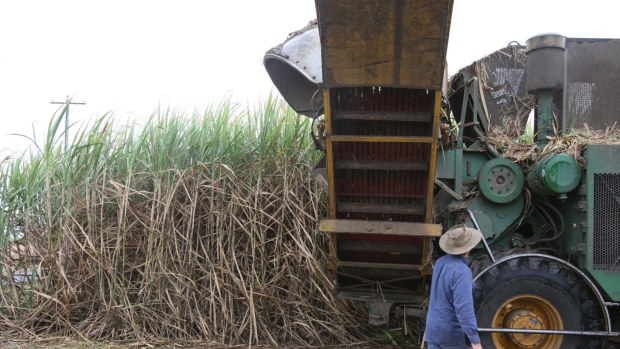Bioenergy: how to turn sugarcane into jet fuel
An innovative Australian biotech leader has recently entered into a partnership to turn sugarcane waste into jet fuel.
It’s an exciting development for the emerging biofuel sector, which is taking Australia’s considerable agricultural waste resource and turning it into green energy.

A sugarcane field is a rich source of fuel. Photo: Peter Braig
Land around the Burdekin River, south of Townsville in north Queensland, is one of the world’s most prolific sugar-growing areas, thanks to an enormous aquifer that sits under the region.
The billet or stalk from the sugarcane goes to the mill, but the cane tops and trash – dead leaves – are byproducts of the harvest that usually go up in smoke, which is an ecological nightmare given the land is so close to the Great Barrier Reef.
Each year, a whopping 5.7 million tonnes of tops and trash is produced in Queensland alone. This material can’t be left in the field because the furrows between the sugarcane rows would get clogged up, preventing water from the aquifer from flowing through them.
At the same time, biofuel manufacturers don’t want the waste to hit the ground because they would have to clean it before it could be used. Enter biotech firm Licella, which takes the tops and trash and converts them into biocrude.
“We can take a range of different feedstocks, both biomass and also waste plastics, and convert them into a synthetic crude oil, which can either be co-processed in refineries or distilled onsite,” says Steve Rogers, head of commercialisation at Licella.
“So we’re not only reducing the amount of fossil fuel we need to dig out of the ground, we’re also providing Australia with fuel security,” he adds.
Huge opportunity
Licella has a joint venture called Arbios Biotech with Canfor, North America’s largest lumber and wood product company. Canfor has recently announced a global alliance with Shell Catalysts and Technologies to add standalone upgraders at the biorefineries to convert its biocrude into finished fuels, including sustainable aviation fuel.
The technology could produce enough fuel to refill 2500 A380 airplanes from Queensland’s sugar cane residue.
This is just one of a huge range of biofuel opportunities of which Australia could take advantage. Given the enormous opportunity, industry body Bioenergy Australia is calling on the federal government to develop a bioenergy road map for the nation.
Biofuels are also a way for regions where fossil fuels play an important role in the economy to transition to renewables.
— Shahana McKenzie, Bioenergy Australia
“We advocated for the development of a bioenergy road map in the lead-up to the last federal election, and we’re hopeful it is going to be released any day now,” says Bioenergy Australia chief executive Shahana McKenzie.
“Bioenergy is a replacement for any fossil-based fuel. For instance, biomethane could become a decarbonised new gas network. It can also be used for sustainable aviation fuels, renewable diesel, renewable marine crude, as well as for passenger vehicle fuels, whether it’s ethanol or biodiesel, all the way through to electricity,” she adds.
Need for government policy
Organic waste streams are already being used to produce high-value bioproducts such as biochemicals, pharmaceuticals and nutraceuticals, which are food-based alternatives to pharmaceuticals.
“The petrochemicals we use every day could ultimately be replaced by products made from organic waste. The challenge we have in Australia is the industry is underdeveloped. But the positive from this is we get to define the future in a strategic way,” McKenzie says.
“That’s why we advocated for a bioenergy road map. We have to identify what Australia’s bioenergy future looks like, areas that have the greatest opportunity for success, areas where we have the greatest competitive advantage and areas that are going to be the hardest to decarbonise through other forms of renewable energy,” she says.
McKenzie argues these are areas that could be supported through favourable bioenergy government policy at federal and state levels. “We also need to focus on investment, building skills and jobs creation, and look at different locations where projects could be based.”
Bioenergy Australia believes sustainable aviation fuel should be a particular area of focus. One reason for this is a commitment by the global aviation industry to a 50 per cent reduction in emissions by 2050, based on 2015 levels. Sustainable aviation fuels will play a big part in achieving these goals.
Says McKenzie: “This is really significant for the growth of our regional areas. For instance, if we want to have a focus on renewable aviation fuel in Townsville, we could supply fuel through the local airport. Biofuels are also a way for regions where fossil fuels play an important role in the economy to transition to renewables.”
All this hinges on the federal government. It will be tough for Australia’s bioeconomy to achieve its potential without policies to support decarbonisation.
The sector is clamouring for the release of the federal government’s bioenergy road map, so it knows where to focus its efforts.
Bioenergy is set to be an important issue in the upcoming federal election and will hopefully play a central role in Australia’s future energy security and economic growth.
Subscribe to gift this article
Gift 5 articles to anyone you choose each month when you subscribe.
Subscribe nowAlready a subscriber?
Introducing your Newsfeed
Follow the topics, people and companies that matter to you.
Find out moreRead More
Latest In Energy
Fetching latest articles